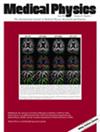Hybrid method for estimating lung ventilation from CT by combining intensity and motion information
Abstract
Background
Functional lung imaging modalities allow for capturing regional lung ventilation information. Computed Tomography based ventilation imaging (CTVI) has been proposed as a surrogate modality that relies on time-resolved anatomical data and image processing. However, generating accurate ventilation maps using solely computed tomography (CT) image information remains a challenging task, due to the need to derive functional information of ventilation from anatomical observations.
Purpose
We introduce the hybrid estimation of computed tomography obtained respiratory function (HECTOR) method that consists of two components: a volume- and a density-based ventilation estimate. For the first component, a deformable image registration (DIR)—based solution for accurate volumetric CTVI generation is proposed, integrating the physical characteristics of the lung deformations in its design. For the second component, an already established air-tissue density model is used. Furthermore, a novel method is developed for combining the two components.
Methods
The proposed method consists of four principal steps: (1) Application of a specially tailored DIR algorithm to estimate respiratory motion between inhale and exhale phases. (2) Conversion of the motion information to volumetric change maps using a variation of the Jacobian determinant method. (3) Computation of a HU-based method that estimates the local product of air-tissue densities. (4) Combination of the metrics estimated in steps 2 and 3 by means of a smooth minimum function.
The proposed approach is validated using the publicly available VAMPIRE dataset consisting of two subgroups: 25 subjects scanned with Galligas 4DPET/CT and 21 subjects scanned with DTPA-SPECT. Another dataset of 18 patients available at The Cancer Imaging Archive (TCIA) was used for further validation. All datasets contain inhale/exhale CT scans paired with ground-truth ventilation images (RefVIs). The CTVIs generated by the proposed HECTOR method were tested against the RefVIs using the Spearman correlation coefficient and Dice overlap of low- and high-function lung (DSC-low and DSC-high, respectively).
Results
The proposed method achieved mean Spearman, DSC-high and DSC-low coefficients of 0.62, 0.55, and 0.59 on the Galligas PET subgroup and 0.49,0,48, and 0.50 on the DTPA-SPECT subgroup of the VAMPIRE dataset. This performance was better than the highest performing method reported in the original challenge. The same metrics for the TCIA dataset were 0.66, 0.60, and 0.60. The proposed hybrid ventilation method achieved higher Spearman correlation scores than the individual volume- and density-based components in all datasets. Additionally, the use of the specially tailored DIR algorithm was found to achieve higher scores than previously reported volume-based methods.
Conclusions
Our work provides a novel processing workflow for CT ventilation imaging that can consistently generate ventilation maps with high fidelity compared to reference approaches. This study also provides further insights into the benefits of combining different types of information to model the complex dynamics of respiratory function. Such information can be useful for potential applications in radiation therapy treatment planning and thoracic dose–response assessment.


 求助内容:
求助内容: 应助结果提醒方式:
应助结果提醒方式:


